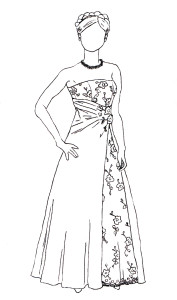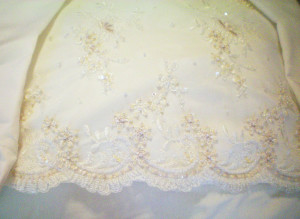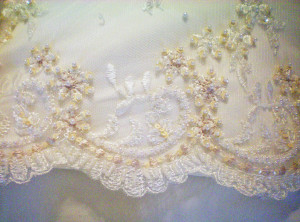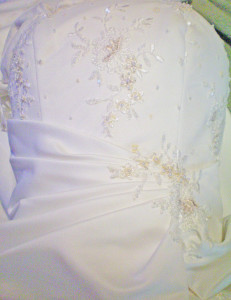by Lisha Vidler
When I got married in August of 2002, so many things went wrong. I won’t go into the whole story here, but we had a string of catastrophes. The biggest disaster was the fact that my parents’ house got struck by lightning just a few weeks before the wedding. As the attic burned, I ran onto the front lawn with my baby sister in one arm and my wedding gown draped over the other!
Though the house was saved, a lot of things were ruined by smoke and water damage, among other things, including the veil I’d hand-embroidered, my wedding jewelry, and the satin sandals I’d bought to wear with my wedding dress. Thanks to our insurance company, I managed to replace nearly everything. And despite all the problems, the wedding turned out beautifully.
Before the happy ending, however, I experienced the stress of dealing with a seamstress who knew absolutely nothing about hemming a wedding gown, despite the sign on the shop window that declared them bridal alterations experts. This is definitely a case of caveat emptor—buyer beware—but I thought I would share the story so others could learn from my mistakes.
(Note: The identity of the incompetent seamstress will not be revealed.)
In Need of a Hem
I bought my gown off-the-rack from a discount bridal shop. It’s strapless, with an empire-waisted overdress that splits open on the side, revealing an underdress overlaid with embroidered lace.
Since I’m rather short (5’3”), the dress ended up being several inches too long. It needed to be hemmed, but I’d lost my sewing machine to the fire and hadn’t had time to replace it. Nor did I have the space to set up a sewing room in the cramped apartment we were living in while they repaired my parents’ house. Thinking to save myself a headache, I took the dress to an alterations shop.
My first mistake? I didn’t research the shop first. I saw the sign advertising bridal gown alterations and walked in. Unfortunately, the sign lied.
Often, a formal gown is shortened from the waist, not the hem. In my case, this was essential, because the skirt of my gown had a scalloped lace overlay—exquisitely embroidered, with a tiny beaded fringe along the scalloped edge. Because of this, you couldn’t simply turn the edge under and hem it.
When I brought the gown to the seamstress, she was strangely reluctant to hem it. Her suggestion was to add a net ruffle to the skirt’s lining, thinking this would poof it out enough to be shorter. Now, this might work if your gown is just a smidgen too short. Such a trick wouldn’t work for my skirt, however, since it was several inches too long.
The problem was, this option was considerably cheaper than actually hemming the dress. And since my mother was paying for the alterations, I felt I had no choice but to agree, despite my misgivings. That was my second mistake.
Needless to say, it didn’t work.
The skirt was fluffier, to be sure, but the length had barely been affected. I pointed out that it was still too long, but the seamstress disagreed. I suppose she’s one of those people who believe formal gowns should drag on the ground.
An Alarming Plan
After we paid for the insufficient poofing, I insisted that the skirt be shortened properly. The seamstress drew up a game plan and showed me what she intended to do.
Rather than shorten the skirt at the waist, she wanted to cut the scalloped lace off the bottom of the skirt, hem the underskirt a few inches shorter, and then sew the lace back on!
I was aghast.
She said she would take care to stitch the lace around the floral embroidery, so it would hardly show. Except it would show, because there would be a seam across the bottom of the lace!
Because of the way the overskirt was joined to the empire bodice, it would be complicated to shorten the hem at the waist . . . but after all, she was a bridal alterations expert, and we were willing to pay whatever she asked. The idea that she wanted to take such a shortcut was quite disturbing.
At this point, I wanted to take my dress home and hem it myself, but I couldn’t. The wedding was just a week away and I still had no sewing machine. I should have walked out and found another alterations shop to hem the dress. I can only assume that my judgment was clouded by the stress of everything—the fire, the wedding, the insurance claims, and living with seven people in a small apartment.
Not quitting was my third mistake.
Gross Incompetence
Begrudgingly, the seamstress agreed to do the hem my way. She opened up the empire waist and shortened it. When I returned for a fitting, I was once again dismayed, for the overskirt now bulged oddly at the waist seam. She specifically pointed this out to prove that she was right, we never should have hemmed it at the waist.
I showed the seamstress exactly how to fix her mistake. It required a simple shift of fabric and a few seconds at the sewing machine. It alarmed me that I actually had to show the “bridal alterations expert” how to properly hem a wedding gown, but what could I do?
Once again, I should have left and found someone else to complete the alterations. I didn’t, and that was my fourth mistake.
With a great deal of trepidation, I left the gown in the seamstress’s hands and made plans to pick it up the day before the wedding. To my relief, she did a competent job of fixing her mistake and hemmed my dress to just the right length.
There was another problem, however. In addition to hemming the gown, she was supposed to prepare the skirt for bustling after the ceremony. Due to the style of my gown, I wanted French bustling, where the skirt is pulled up from underneath, with hooks or buttons hidden on the underside of the skirt. I described and demonstrated what I wanted, until I was sure she understood. She said it would cost extra, as opposed to regular bustling, which seemed a bit strange, but I agreed to her fee.
That was my fifth mistake.
To my disappointment, after the wedding I found that, instead of the sophisticated French bustling I’d requested, I’d been given a few apparently random pick-ups in the back.
In addition, the way the seamstress had done the bustling was incomprehensible. Instead of a few hooks and eyes sewn to the skirt’s seam allowance, like I was expecting, she’d installed a bizarre system of ribbons and plastic loops. She didn’t label or color-code them, so it was nearly impossible to figure out which ribbons were meant to be tied to which loops. To bustle the skirt after the wedding ceremony required the assistance of both my mother and a friend, and with the two of them working on it, it still took more than ten minutes for them to bustle the skirt.
The end result didn’t look bad, but it was a far cry from the expensive French bustling we’d paid for.
Conclusion
Lest you think I’m merely picking on the poor seamstress, keep in mind the fact that this was someone who does bridal alterations for a living. We hired her to do two things: shorten the gown and add French bustling. She got both of them wrong, even with me demonstrating how they ought to be done. The hem was eventually sorted, but she never bothered to remove the useless netting from the skirt’s lining. And the bustling mistake wasn’t discovered until after the wedding ceremony, too late to have it fixed.
In spite of everything, my wedding was lovely. But the alterations nightmare added a great deal of aggravation to an already stressful situation. So, how can you prevent a similar disaster from ruining your big day?
- Do some research before you choose a seamstress. If you can’t find any reviews of her shop online, talk to the seamstress about what you need her to do. Ask to see samples of her work and make sure she knows what she’s doing!
- If she hesitates over any aspect of the job, find out why. Is she unfamiliar with the necessary sewing techniques? Or is it merely a lot of work?
- If she suggests something you don’t agree with, be polite but firm. Don’t let her bully you into paying for something you don’t want.
- Talk about your concerns. Ask her to explain what she wants to do, and why. Don’t let her impress (or confuse) you with incomprehensible sewing lingo. Make sure she explains things in terms you can understand.
- Don’t let her do something to your dress that you’re not one-hundred percent sure of. If you’re worried about something and she can’t ease your fears, walk away.
- Above all, listen to your gut feelings. Don’t be afraid to take your business elsewhere!







Pingback: An Alterations Nightmare | Yesterday's Thimble